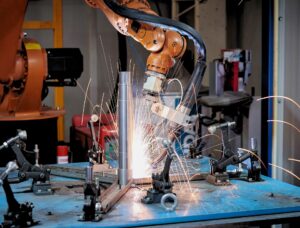Welding is a skill that demands precision, patience, and attention to detail. Even experienced welders can fall into bad habits that compromise weld strength, appearance, and safety. Whether you’re handling MIG welding, TIG welding, or metal arc welding, discover how to avoid the most common welding mistakes by using the right weld monitoring camera.
1. Skipping Base Metal Preparation
The Mistake: Jumping straight into welding without cleaning the workpiece can lead to contamination, porosity, and weak joints.
Why It Matters: Oils, rust, paint, or mill scale can cause weld defects and prevent proper fusion.
How to Avoid It:
- Clean with a wire brush or grinder.
- Use acetone or degreasers for removing oils.
- For stainless steel and aluminum, remove oxide layers carefully.
- Use welding visual inspection tools to confirm cleanliness before welding.
2. Poor Fit-Up and Alignment
The Mistake: Inconsistent gaps, misalignment, or lack of clamping can distort welds or lead to incomplete penetration.
Why It Matters: Improper joint fit-up creates uneven welds and stress concentrations that can cause failure under load.
How to Avoid It:
- Use jigs, clamps, or fixtures to hold parts securely.
- Tack weld strategically to maintain alignment.
- Inspect joints with a weld monitoring system before committing to full weld passes.
3. Rushing Weld Passes
The Mistake: Moving too quickly can result in weak fusion, excessive spatter, and uneven bead profiles.
Why It Matters: Fast travel speeds can cause undercutting or shallow penetration, reducing joint strength.
How to Avoid It:
- Practice steady hand movements and consistent speed.
- Use the right amperage and voltage settings for your process.
- Monitor arc behavior using a camera for welding to ensure uniform coverage.
4. Incorrect Electrode or Filler Selection
The Mistake: Using the wrong filler material or electrode size for the base metal or application.
Why It Matters: This can lead to cracking, porosity, or lack of ductility—especially in dissimilar metal welding.
How to Avoid It:
- Match filler materials based on welding codes and material type.
- For TIG welding, double-check tungsten type and shielding gas selection.
- In MIG and MAG welding process, adjust wire feed and shielding gas to suit the metal.
5. Neglecting Shielding Gas Coverage
The Mistake: Inconsistent gas flow or improper nozzle positioning can lead to oxidation and porosity.
Why It Matters: Without proper shielding, the molten weld pool is exposed to atmospheric contamination.
How to Avoid It:
- Check for leaks or blockages in your gas line.
- Maintain appropriate gas flow rate (typically 15–25 CFH for most applications).
- Use a welding inspection camera to observe gas coverage during welding.
6. Improper Welding Technique
The Mistake: Inconsistent travel angle, wrong electrode angle, or poor manipulation of the torch.
Why It Matters: Poor technique results in weak, uneven welds and inconsistent penetration.
How to Avoid It:
- Maintain a proper work angle (typically 10–15° push or drag depending on the process).
- Keep a short arc length.
- Practice uniform motion and use arc welding image feedback to improve technique.
7. Overheating or Excessive Heat Input
The Mistake: Using too much current or lingering too long in one spot.
Why It Matters: Excess heat causes distortion, burn-through, and weakened welds.
How to Avoid It:
- Dial in the correct parameters for your welding equipment.
- Use stringer beads instead of weaving on thin materials.
- A high-speed welding camera can help track heat input in real-time.
8. Ignoring Weld Inspection
The Mistake: Failing to inspect your work or relying only on visual checks.
Why It Matters: Hidden defects like porosity, slag inclusion, or incomplete fusion may not be obvious.
How to Avoid It:
- Use non-destructive testing (NDT) methods when applicable.
- Incorporate welding inspection techniques into your routine.
- Invest in a weld monitoring camera for live feedback and archiving for quality control.
Conclusion: How to Avoid the Most Common Welding Mistakes
Avoiding these common welding mistakes can be the difference between a strong, lasting weld and a costly failure. Proper prep, technique, and inspection are key to consistent results.
Welding cameras are becoming an essential tool in modern fabrication—offering real-time visibility, improving welding quality, and catching errors before they become problems.
Looking to upgrade your weld monitoring setup? Mecaweld offers high-performance welding cameras tailored for TIG, MIG, laser welding, and more. Contact us today to find the right system for your operation.



